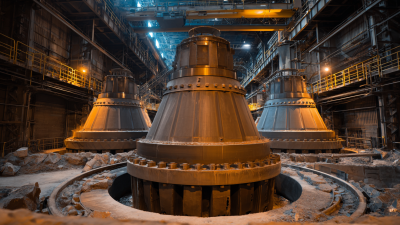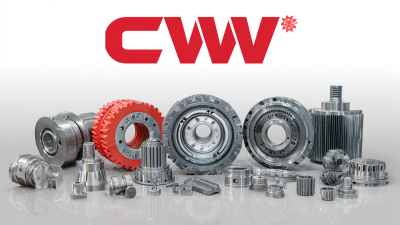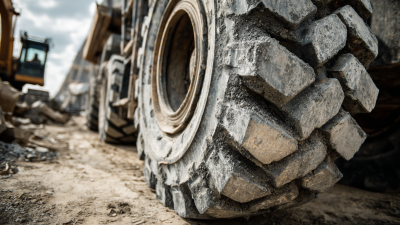
-
Home
-
About Us
-
Products
-
News
-
Blog
-
Contact Us
Leave Your Message

In the rapidly evolving landscape of sustainable industrial practices, the significance of "Scrap Metal Recycling Wear Parts" cannot be overstated. As industries strive to minimize their ecological footprint, the recycling of scrap metal has emerged as a crucial component in achieving these goals.
According to the Institute of Scrap Recycling Industries (ISRI), the recycling of metals results in substantial energy savings, with recycled aluminum using 95% less energy compared to primary production. Furthermore, the American Iron and Steel Institute (AISI) reports that recycling steel reduces greenhouse gas emissions by 64% compared to producing new steel.
With the global focus on sustainable manufacturing, understanding the processes, benefits, and best practices for recycling wear parts not only fosters economic efficiency but also contributes significantly to environmental conservation. This article will explore practical approaches to enhancing the effectiveness of scrap metal recycling wear parts in industrial applications.

Scrap metal recycling plays a crucial role in fostering sustainable industry practices by reducing raw material consumption and minimizing waste. As industries increasingly recognize the environmental impact of their operations, the importance of recycling wear parts made from metals has surged. By reclaiming valuable materials from end-of-life products, manufacturers can significantly decrease the need for new metal extraction, which is often energy-intensive and harmful to the environment.
Additionally, the recycling of scrap metal contributes to a circular economy, where materials are reused and repurposed rather than discarded. This not only alleviates the pressure on landfills but also lowers greenhouse gas emissions associated with the production and disposal of metal goods. By integrating scrap metal recycling into their practices, industries are taking proactive steps toward sustainability, ensuring that resources remain in use for as long as possible, while simultaneously supporting economic growth by creating jobs in the recycling sector.
| Material Type | Recycling Rate (%) | Environmental Impact Reduction (ton CO2) | Economic Value ($ per ton) | Applications |
|---|---|---|---|---|
| Steel | 90% | 1.5 | 250 | Construction, Automotive |
| Aluminum | 95% | 2.0 | 800 | Packaging, Aerospace |
| Copper | 88% | 3.5 | 6000 | Electrical, Plumbing |
| Lead | 75% | 4.0 | 1600 | Batteries, Radiation Shielding |
| Zinc | 50% | 1.0 | 1200 | Coating, Alloys |
Recycling wear parts plays a crucial role in environmental conservation, significantly reducing industrial waste. Wear parts, which are essential components in machinery, inevitably undergo wear and tear, leading to replacement. Instead of discarding these components, recycling offers a sustainable solution that minimizes resource extraction and energy consumption. By reprocessing materials derived from used wear parts, industries can lessen their environmental footprint while conserving valuable natural resources.
Additionally, the recycling of wear parts contributes to a circular economy, where materials are reused and repurposed rather than disposed of. This process encourages manufacturers to design products with longevity in mind, fostering innovation in material recovery and processing technologies. Implementing recycling practices not only conserves energy but also decreases greenhouse gas emissions associated with raw material extraction and production. As a result, industries can make significant strides toward sustainability while maintaining cost-effectiveness in their operations.
Scrap metal recycling has emerged as a cornerstone of sustainable industry practices, particularly within the manufacturing sector. According to a report by the Institute of Scrap Recycling Industries (ISRI), the U.S. recycling industry contributed approximately $110 billion to the economy in 2020, showcasing the significant economic advantages of utilizing scrap metal. By reprocessing used metals, manufacturers can reduce the need for virgin material extraction, translating to lower production costs and enhanced profitability. In fact, the National Recycling Coalition estimates that for every job in recycling, there are 1.17 jobs created in manufacturing, highlighting the symbiotic relationship between recycling and economic growth.
Furthermore, recycled metals such as steel, aluminum, and copper have been shown to maintain a competitive edge in terms of cost efficiency. The Aluminum Association reports that recycling aluminum saves up to 95% energy compared to producing new aluminum from raw materials. This energy conservation translates into real financial savings, as energy costs comprise a significant portion of manufacturing expenditures. As industries strive for sustainability, the economic incentives of scrap metal recycling become increasingly clear, offering not just environmental benefits but also a pathway to enhanced operational efficiency and profitability.
In recent years, innovative approaches to scrap metal management have emerged, significantly enhancing the sustainability of industrial practices. According to a report by the Institute of Scrap Recycling Industries (ISRI), recycling scrap metal achieves an energy savings of up to 95% compared to producing new metal from raw materials. This statistic underscores the critical role of scrap metal recycling in reducing greenhouse gas emissions and conserving natural resources. For industries seeking to minimize their environmental footprint, adopting advanced recycling techniques not only aligns with sustainability goals but also contributes to cost savings and resource efficiency.

One notable innovation in scrap metal management is the integration of digital technologies, such as artificial intelligence and blockchain. A survey conducted by MarketsandMarkets revealed that the global metal recycling market is projected to reach $406 billion by 2027, driven by increased adoption of these technologies. AI can optimize sorting processes, enhancing the quality of recycled materials, while blockchain provides transparency in the supply chain. These advancements facilitate more responsible sourcing and disposal of scrap metal, bolstering the industry's commitment to sustainable practices and encouraging a circular economy.
Implementing wear parts recycling programs faces several challenges, including logistics, material identification, and financial constraints. Many industries struggle with the collection and transportation of scrap metal, which can create inefficiencies in the recycling process. Additionally, distinguishing recyclable wear parts from non-recyclable materials is crucial but often complicated. Organizations must invest in training and resources to ensure proper classification and separation of materials to maximize recycling efficiency.
Tips: To streamline your wear parts recycling process, consider partnering with local recycling firms that specialize in scrap metal. This can not only improve logistics but also enhance your understanding of the material flow. Regular training sessions for staff can also help in identifying recyclable parts, reducing waste, and increasing the overall recycling rate.
Another significant challenge is financial viability. Some businesses may perceive recycling initiatives as an added expense rather than an investment. It's essential to demonstrate the long-term cost savings and sustainability benefits of recycling programs. By implementing an effective wear parts lifecycle management strategy, industries can minimize costs and environmental impact, positioning themselves as responsible players in the market.
Tips: Start by conducting a cost-benefit analysis of your recycling program. Highlight potential savings from reduced raw material purchases and landfill fees. Engaging employees in sustainability efforts can also foster a culture of environmental responsibility, driving further participation in the recycling programs.






